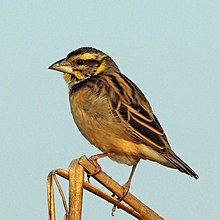Black-breasted weaver
| Black-breasted weaver | |
|---|---|

| |
| Breeding male in northern India | |

| |
| Female or non-breeding male in Uttar Pradesh, India | |
| Scientific classification | |
| Domain: | Eukaryota |
| Kingdom: | Animalia |
| Phylum: | Chordata |
| Class: | Aves |
| Order: | Passeriformes |
| Family: | Ploceidae |
| Genus: | Ploceus |
| Species: | P. benghalensis
|
| Binomial name | |
| Ploceus benghalensis | |
| Synonyms | |
|
Loxia benghalensis Linnaeus, 1758 | |
The black-breasted weaver (Ploceus benghalensis), also known as the Bengal weaver or black-throated weaver, is a weaver resident in the northern river plains of the Indian subcontinent. Like the other weavers, the males build an enclosed nest from reeds and mud, and visiting females select a mate at least partially based on the quality of the nest.
Taxonomy
The black-breasted weaver was
Description
The black-breasted weaver is sparrow-sized with a total body length of about 15 cm. The male in breeding plumage has a brilliant golden-yellow crown and a variable amount of black on the head and breast; some males have an entirely black head (apart from the yellow crown) and breast, while others have a white throat or an entirely white face with a black band separating it from the fulvous-white underparts. In the non-breeding male and female, the crown is brown like the rest of the upperpart plumage, and the black pectoral band is less developed. It has a prominent supercilium, a spot behind ear, and narrow moustachial streaks, which are pale yellow. Flocks frequent cultivation and the reedy margins of tanks and jheels (shallow lakes), or extensive tall grass areas.[6]
Distribution
Resident or local migrant, endemic to
Behaviour
It is polygynous and colonial, and on the whole similar to that of the baya and streaked weavers.
Breeding
Breeding takes place between June and September. Nests are in scattered groups of 4 or 5; sometimes larger colonies. The male constructs the nest single-handedly, with a group of females visiting it during late construction stage, jumping on the helmets, tugging and testing, presumably for strength. If a female appears interested, the male bows low before her, presenting his golden crown to her. He flaps his wings deliberately and sings softly tsi-tsisik-tsisik-tsik-tsik, like the chirp of a cricket or the subdued squeaking of an unoiled bicycle wheel. Once the female agrees and permits copulation, he quickly completes the rest of the nest, and she lays her eggs inside. He immediately commences a second nest nearby to attract other females, and occasionally a third nest, or very rarely a fourth. Nests not accepted by females may be torn down by the builder himself.[8]
The nest is similar to that of the
Gallery
-
Male in breeding plumage in South India
-
Nest suspended from grass, India
References
- . Retrieved 12 November 2021.
- ^ Linnaeus, Carl (1758). Systema Naturae per regna tria naturae, secundum classes, ordines, genera, species, cum characteribus, differentiis, synonymis, locis (in Latin). Vol. 1 (10th ed.). Holmiae (Stockholm): Laurentii Salvii. p. 175.
- ^ Albin, Eleazar; Derham, William (1734). A Natural History of Birds : Illustrated with a Hundred and One Copper Plates, Curiously Engraven from the Life. Vol. 2. London: Printed for the author and sold by William Innys. p. 48, Plate 52.
- ^ Edwards, George (1751). A Natural History of Uncommon Birds. Vol. 4. London: Printed for the author at the College of Physicians. p. 189, Plate 189.
- ^ Gill, Frank; Donsker, David; Rasmussen, Pamela, eds. (December 2023). "Old World sparrows, snowfinches, weavers". IOC World Bird List Version 14.1. International Ornithologists' Union. Retrieved 9 February 2024.
- Ali, Salim; J C Daniel (1983). The book of Indian Birds, Twelfth Centenary edition. New Delhi: Bombay Natural History Society/Oxford University Press.
- ISBN 978-0-691-04910-6.
- ^ Ali, Salim; Sidney Dillon Ripley(2001) [1986]. Handbook of the Birds of India and Pakistan, 2nd ed., 10 vols (2nd ed.). New Delhi: Oxford University Press. Synopsis / Handbook Number 1012, vol. 10, p. 100-102. For black-breasted weaver behaviour and nest, quotes articles by Cooke (JBNHS v.60:1-48) and Ambedkar (JBNHS:69:268-82).
External links
- Black-throated Weaver - Species text in Weaver Watch.



